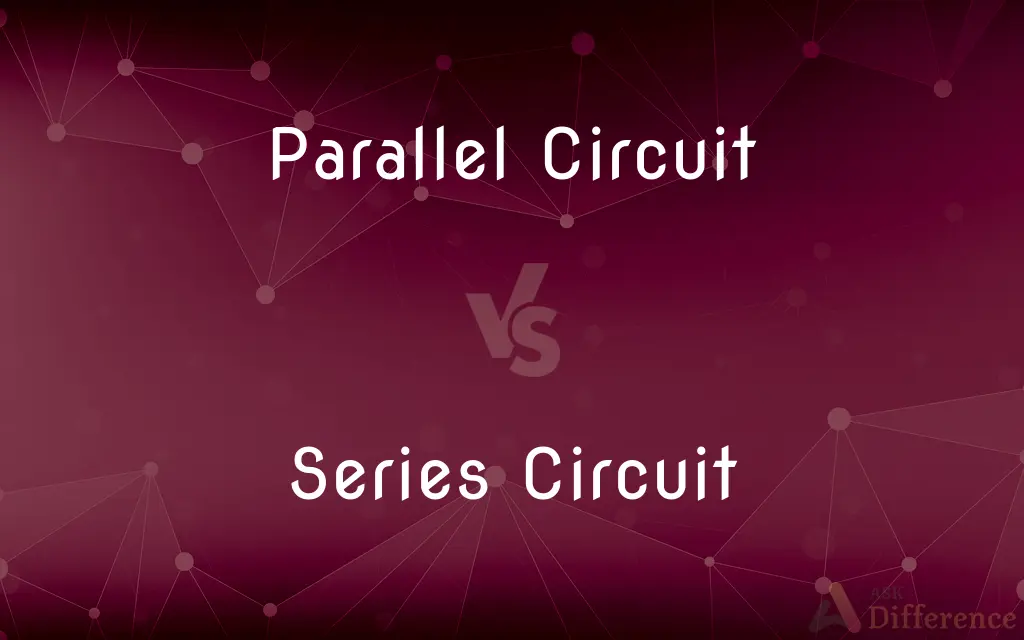Parallel Circuit vs. Series Circuit — What's the Difference?
By Tayyaba Rehman — Published on October 10, 2023
In a parallel circuit, components are connected independently, creating multiple paths for current to flow. In contrast, a series circuit has components connected end-to-end, offering only a single path for current to follow.

Difference Between Parallel Circuit and Series Circuit
Table of Contents
ADVERTISEMENT
Key Differences
A Parallel Circuit allows electrical current to move through several paths, ensuring that a break in one path doesn’t stop the flow in others. Contrastingly, a Series Circuit provides only one path, so if there is a break anywhere, the entire circuit is interrupted.
In a Parallel Circuit, each component operates independently; if one fails, others continue working, as they’re not on the same current path. In a Series Circuit, however, all components are dependent; if one fails, the entire circuit ceases to function due to the single pathway.
Voltage remains constant across all components in a Parallel Circuit, meaning each component experiences the full voltage of the power source. Whereas in a Series Circuit, voltage divides among the components, so each may receive only a fraction of the source voltage.
Resistance is another distinct difference. In a Parallel Circuit, the total resistance decreases as more components are added. In a Series Circuit, adding more components increases the total resistance, as it adds to the single path through which the current must move.
A Parallel Circuit is often used in residential wiring to ensure that the failure of one electrical appliance does not affect others. Conversely, Series Circuits are common in battery-operated string lights, where the failure of one bulb will break the circuit and affect all bulbs.
ADVERTISEMENT
Comparison Chart
Current Path
Multiple paths for current.
Single path for current.
Voltage Distribution
Consistent across components.
Divides among components.
Resistance
Decreases with added components.
Increases with added components.
Failure of One Component
Doesn’t stop entire circuit.
Stops entire circuit.
Use Case
Useful where continuity is crucial.
Applied where simplicity and cost-effectiveness are prioritized.
Compare with Definitions
Parallel Circuit
Parallel Circuit allows independent operation of all connected components.
The Parallel Circuit ensures that turning off one appliance does not affect others connected to it.
Series Circuit
A Series Circuit connects all components end-to-end, providing a single pathway for electric current.
Old Christmas lights used a Series Circuit, causing all to go dark if one bulb failed.
Parallel Circuit
Parallel Circuit ensures that the failure of one component does not impact the functionality of others.
In a Parallel Circuit, if one light bulb burns out, the others remain lit.
Series Circuit
Series Circuit is often utilized for its simplicity and minimal wiring.
A Series Circuit is often chosen for battery-operated devices due to its straightforward design.
Parallel Circuit
Parallel Circuit exhibits reduced total resistance as more components are added.
Installing additional resistors in a Parallel Circuit will decrease the overall resistance.
Series Circuit
Series Circuit sees a division of the source voltage across its components.
Bulbs in a Series Circuit may glow dimmer as more are added, due to the voltage division.
Parallel Circuit
In a Parallel Circuit, the voltage across all components remains constant.
All bulbs in a Parallel Circuit shine with consistent brightness since they all receive the same voltage.
Series Circuit
In a Series Circuit, the total resistance is the sum of the individual resistances.
Adding more bulbs to a Series Circuit will increase its total resistance.
Parallel Circuit
A Parallel Circuit allows electric current to flow through multiple independent pathways.
The electrical outlets in homes are typically wired in a Parallel Circuit.
Series Circuit
Series Circuit implies that the failure of one component will cease the functioning of the entire circuit.
If one element breaks in a Series Circuit, the path for the current is interrupted, affecting all components.
Common Curiosities
Where might you find a Series Circuit in daily life?
In string lights where the failure of one bulb affects all.
What happens when a bulb burns out in a Parallel Circuit?
Other bulbs or components continue to work.
What occurs if a component fails in a Series Circuit?
The entire circuit stops functioning.
How does adding resistors affect total resistance in Parallel Circuits?
It decreases the overall resistance.
What is a real-world example of a Parallel Circuit?
Household electrical wiring often uses Parallel Circuits.
How does voltage distribution differ in Parallel and Series Circuits?
It's constant in Parallel Circuits and divided in Series Circuits.
How is total resistance impacted by adding components to Series Circuits?
Total resistance increases.
Why might Parallel Circuits be preferred for home wiring?
To ensure the failure of one appliance doesn’t impact others.
Can the brightness of bulbs vary in a Parallel Circuit?
Generally no, since all bulbs receive the full voltage.
What happens to the brightness of bulbs in a Series Circuit if more are added?
They may dim, due to the division of voltage.
Can components be switched on/off independently in a Parallel Circuit?
Yes, due to their independent connection to the voltage source.
Is it easy to add new components to a Series Circuit?
Yes, but it may affect the voltage across each component.
Is the wiring of a Parallel Circuit more complex than a Series Circuit?
Yes, due to creating multiple independent paths for the current.
What will happen to remaining bulbs in a Series Circuit if one is unscrewed?
They will go out, as the circuit is broken.
Why might Series Circuits be chosen for certain applications?
For their simplicity and cost-effectiveness.
Share Your Discovery

Previous Comparison
Positional Power vs. Personal Power
Next Comparison
Bearer Cheque vs. Order ChequeAuthor Spotlight
Written by
Tayyaba RehmanTayyaba Rehman is a distinguished writer, currently serving as a primary contributor to askdifference.com. As a researcher in semantics and etymology, Tayyaba's passion for the complexity of languages and their distinctions has found a perfect home on the platform. Tayyaba delves into the intricacies of language, distinguishing between commonly confused words and phrases, thereby providing clarity for readers worldwide.
















































